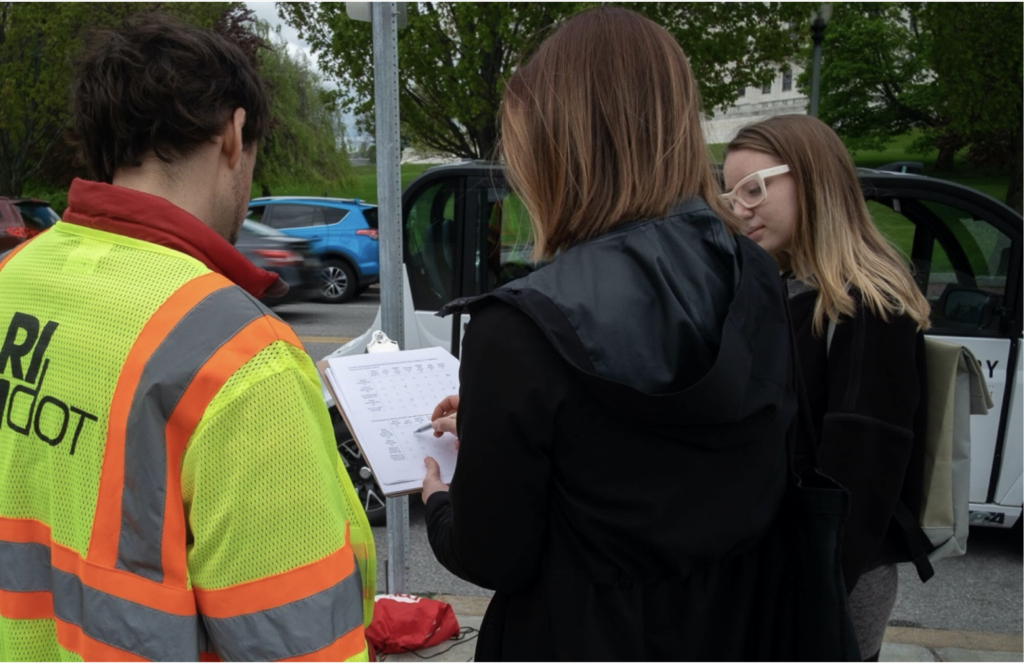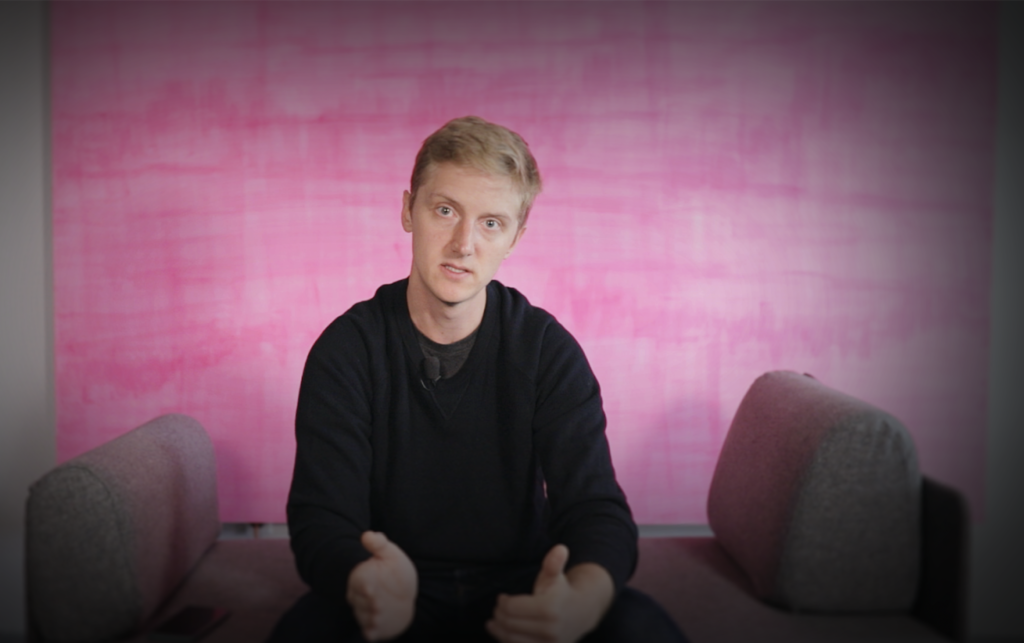Gallery installations at EPIC2019 evoked multi-modal experiences of ethnographic practice—written, oral, visual, three-dimensional, interactive, critical, reflective. These creative projects offered conference attendees diverse experiences of agency and ethnography. The conference committee made an open call for proposals and selected installations through anonymous review.
Gallery Committee
Chair:
Carolina Amiguet, Google
Installations
The Ethno-graphic Sensibility, Jamie McPike & Diana Graizbord
Socially Informed Policy and Planning for AV Mobility in Rhode Island, Kate Fisher
Agency via Avatar Emotions in Virtual Reality, Ayfer Gokalp & Jacqueline Pospisil
Office Humour, James O’Neill, Francesco Pini & Frauke Hein
What Are Memories Made of?, Hema Malini Waghray
Debris, Daria Loi & Heather McGeachy
Interactive Storytelling: Bringing Personas to Life through an AR/VR Experience, Idil Berkan, Amy Lasater-Wille & Alan Finch
Density Done Right: Co-designing Walkable, Sustainable, and Equitable Communities through Digital and Analog Mediums of Public Engagement, Brian Strawn, Karla Sierralta, Alisa Weinstein & Rebecca Buck
Vær: On Place, Weather, Being, and Agency, Erica Kowsz & Hunter Styles
hi how r u: A Toolkit for Digital Expression, Erin Ryan
Where Does Cancer Live Now?, Jacob McAuliffe & Rebekah Park
The Ethno-Graphic Sensibility
JAMIE McPIKE, Instagram
DIANA GRAIZBORD, University of Georgia
ANNA LeBER, Independent Artist
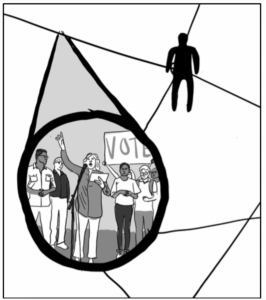 Ethnography is both a set of tools and a way of approaching the world, but ethnographic methods texts tend to reduce ethnography to its tools, minimizing the humanistic elements of our work and ignoring how these tools interact with the social world. Recent work on “ethnographic thinking” helps us shift from an instrumental focus on tools, but we believe that if “the medium we think in defines what we can see”, then textual, linear narratives limit our ability to see and learn about the sensory, embodied, aesthetic, and emotive dimensions of ethnography. We, therefore, ask: how might we reimagine how we teach and learn about ethnography and the ethnographic sensibility? How can we teach beyond the tools? Comics as a medium affords multiple possibilities for expressing the complex dimensions of ethnography. Comics, like ethnography, allows for the simultaneous representation of multiple ideas, perspectives, and experiences. It requires the reader to participate and grapple with the setting, the emotions of the process, the visual feel and mood of a place, and enables a “you are there” sense of place due to the juxtaposition of visual and textual forms. We believe comics can help aspiring ethnographers explore the dynamism inherent in this work. Image: “The Space Between” by Anna LeBer
Ethnography is both a set of tools and a way of approaching the world, but ethnographic methods texts tend to reduce ethnography to its tools, minimizing the humanistic elements of our work and ignoring how these tools interact with the social world. Recent work on “ethnographic thinking” helps us shift from an instrumental focus on tools, but we believe that if “the medium we think in defines what we can see”, then textual, linear narratives limit our ability to see and learn about the sensory, embodied, aesthetic, and emotive dimensions of ethnography. We, therefore, ask: how might we reimagine how we teach and learn about ethnography and the ethnographic sensibility? How can we teach beyond the tools? Comics as a medium affords multiple possibilities for expressing the complex dimensions of ethnography. Comics, like ethnography, allows for the simultaneous representation of multiple ideas, perspectives, and experiences. It requires the reader to participate and grapple with the setting, the emotions of the process, the visual feel and mood of a place, and enables a “you are there” sense of place due to the juxtaposition of visual and textual forms. We believe comics can help aspiring ethnographers explore the dynamism inherent in this work. Image: “The Space Between” by Anna LeBer
Jamie McPike is a User Experience Researcher at Instagram with a PhD in Sociology. For nearly a decade, she has used ethnography to bring tangible changes to policies, programs, and products in diverse sectors. mcpikejamie@instagram.com
Diana Graizbord is Assistant Professor of Sociology and Latin American and Caribbean Studies at the University of Georgia. Her research examines expertise in politics and how ethnography and sociological storytelling can inform policy. dgraizbord@uga.edu
Anna LeBer is an illustrator and designer with a BFA from the University of Georgia. She works in diverse design media, from fine art and illustration to web and print design. anna.e.leber@gmail.com
Socially Informed Policy and Planning for Autonomous Mobility
KATE FISHER, 3×3
Autonomous vehicles as a mode of public transportation offer the potential to grow public and private sector partnerships, improve mobility, strengthen the economy, reduce negative environmental impacts, and benefit the health and well-being of citizens. But these advantages will only materialize if technology is designed with the right foresight, aligned around public awareness and sentiment, and is planned with communities.
Starting in Spring 2019, the first national public AV shuttle pilot was implemented in Providence through the Rhode Island Department of Transit along the Woonasquatucket Corridor to fill a critical transportation gap in the city. The gallery presents insights from the multidisciplinary research, including ethnographic methods, featuring the participatory design tools used throughout Providence. The research objectives are to A) inform Rhode Island’s planning and regulation related to transportation innovations, B) help improve the shuttle’s user experience and service delivery, and C) contribute to a broader policy and scholarly discussion of how residents, businesses, and regulators interaction with new transportation technologies.
3×3 helps civic organizations collaborate with their stakeholders, apply insights from applied research to design initiatives, and produce outputs that unlock social value.
Kate Fisher is a Program Manager and Strategist at 3×3 Design. She brings her background in user experience design, research, policy analysis, and participatory planning to public sector and social impact projects.
Exploration of the Value of Facially Expressive Avatars with VR Developers
AYFER GOKALP, Facebook AR/VR
JACQUELINE POSPISIL, Facebook AR/VR
Ayfer Gokalp and Jacqueline Pospisil are Facebook user experience researchers from Seattle, Washington, United States, and they focus on the development of software and hardware products within the virtual reality (VR) space. For this research, they explored the value of a facially expressive avatars for avatars in VR. Facially expressive avatars is a research prototype that allows users to reflect their real facial gestures on their virtual avatars in real-time. For example, if you smile, your virtual avatar smiles as well. They conducted focus groups with VR developers about the potential value of facial expressiveness and found that expressing both positive emotions (e.g., happiness, excitement, and humor) and negative emotions (e.g., confusion, fear, disgust) are valuable for VR avatars. For instance, expressing fear or disgust facially while playing a zombie game would be more authentic and more immersive. In this gallery presentation you will have the opportunity to try an Oculus VR headset and demo an immersive experience. You will continue by creating your own avatar and edit how it looks. This demonstration will serve as an example of the current state of social VR experiences, and highlight how face-mimicking can improve the users’ virtual reality experiences by allowing them to express a wide variety of emotions and build agency within social VR experiences.
Ayfer Gokalp is a User Experiences Researcher at Facebook. Ayfer’s research focuses on the meaningful social interactions, inclusion, and integrity in virtual reality spaces. She holds a PhD in Linguistic Anthropology from Arizona State University. Her research at Facebook has contributed to the social VR platform, Horizon, that is recently announced. Ayfer has been informing the AR/VR industry and academics about the importance of inclusion in user research by giving talks at conferences. Prior to Facebook, Ayfer worked as a Design Researcher at HTC, where she conducted research on augmented reality technology. You can reach out to her at linkedin.com/in/ayfergokalp.
Jacqueline Pospisil is a hardware researcher at Facebook, where she focuses her research on the comfort and usability of virtual reality hardware products as well as emerging virtual reality use cases. She holds an M.S in Psychology and a certificate in Human-Centered Design and Engineering from the University of Washington. Her work at Facebook has contributed to the Oculus Rift S and Oculus Quest hardware design, as well as the Oculus Quest First Steps onboarding experience. Prior to Facebook, Jacqueline served as a user researcher at HTC, where she conducted research for the development of Vive-branded virtual reality applications such as ViveportVR and Vive Video. Please reach out to her at jacqueline.pospisil@oculus.com with any questions about her work.
Office Humour: Diegetic Explorations of Negotiated Algorithmic and Human Agency
JAMES O’NEILL, Fjord Dublin
FRAUKE HEIN, Fjord Dublin
Office Humour is a speculative design piece that explores the culture that might emerge when data points like laughter function as a performance metric. The piece raises questions about agency at multiple levels. Humans can adapt their culture to algorithmic motoring. But is that ok? Do we allow humans and machines the agency to develop their culture together, or should one always be subject to the other? Who has agency in this situation? The humans who create the laughter, or the algorithm who instigates it?
The piece functions on the basis of a neural network to take live measurements of laughter from its environment and places them within the narrative of a satirical productivity product. Participants are invited to interact with the product. As they do, they experience how laughter—a very natural and personal sound—can be turned into a data point and used to police and monitor their performance in an inhuman way.
The piece tells a story that encourages participants to reflect on the sorts of data they gather in their work and the purposes to which any data may be put in the future.
James O’Neill is a Service & Systems Design Lead at Fjord Dublin which is part of The Dock, Accenture’s flagship R&D center. His research focuses mainly on the human experience of AI enabled systems. james.o.neill@fjordnet.com
Frauke Hein is a Data Designer at Fjord Dublin at The Dock, Accenture’s flagship R&D center. Her work transforms AI technologies into visual and interactive experiences. frauke.hein@fjordnet.com
What Are Memories Made Of? A Migrant Community’s Experience of Agency in 18th Century Hyderabad, India
HEMA MALINI WAGHRAY, marginaliaa.com
This gallery exhibit is a slice of micro history of the Brahma Kshatriya Community of Hyderabad- a migrant Hindu community that moved into a Muslim dominated city in mid-1700s, with Urdu as the state language until 1948. At one level, agency is constituted by creating this archive with data gathered through ethnographic in-depth interviews, collecting photographs, videos, maps, artifacts and diaries. Agency at another level is where this diverse community constituted itself as a group with shared set of rules and institutions related to cooperation, interdependence, a way of life that was culturally syncretic, supporting education, providing financial support to members, setting up social and religious reforms to enable a progressive outlook and lay a foundation for stable growth.
A brass plate or paraath, utilized in a large family or community gathering was borrowed by people in the neighborhood. It is 18 inches in diameter and is about five pounds in weight. This particular plate belonged to my husband’s family and it was a token return gift at a wedding, and all the members of this particular wedding party, in 1911, received it. The inscription written is the name of the person who got married- a symbol of syncretism. It reads “Eknath Pershad, grandson of Nand Lal” and it is written in Urdu which was the medium of instruction and common parlance through the 1900s in Hyderabad, India.
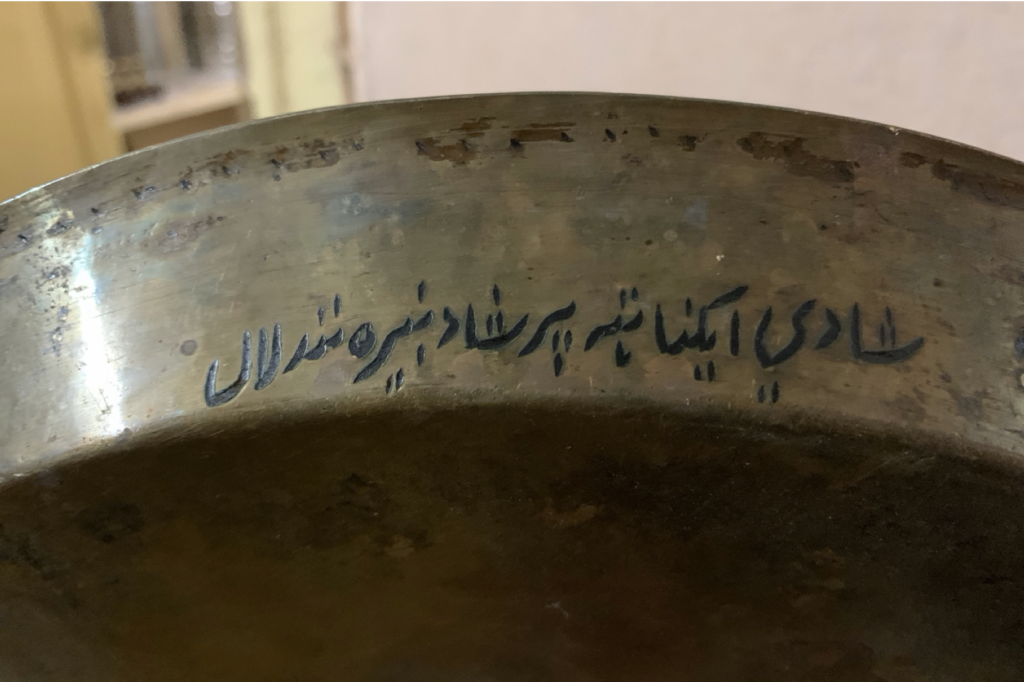
Photo: Brass Metal Plate or Paraath by Hema Malini Waghray
Hema Malini Waghray is a UX researcher from New Jersey and a sociologist by training. Her client is Krishnakriti Foundation, Hyderabad, India and she is the primary investigator for a project to create a micro history of her community in her hometown of Hyderabad, India.
Debris: Intermingling Ethnography with Design and Artistic Practice
DARIA LOI, Mozilla Corporation
HEATHER McGEACHY, Mozilla Corporation
This Gallery proposal focuses on the debris left behind by human’s daily interactions with non-human agents, with the end goal of providing arts-infused lenses to investigate and help untangle our complex relationships with smart systems. Debris is the outcome of a process that intermingles ethnographic tactics with design probing techniques and artistic practice. The Debris – a series of art pieces resulting from this process – are offered to the EPIC 2019 community alongside artefacts that were used to inform art pieces: ethnographic data collected during the interviews, probing toolkit used to augment interview data, and the thought process of the two involved ethnographers/designers/artists, in the form of notes and sketches.
This collection of art pieces, objects, visual commentaries, humans-about-machines accounts represent the fragments that are left behind by human interactions with smart agents – we offer them to prompt reflections, re-connections, and re-discoveries of human-non-human hybrid landscapes.
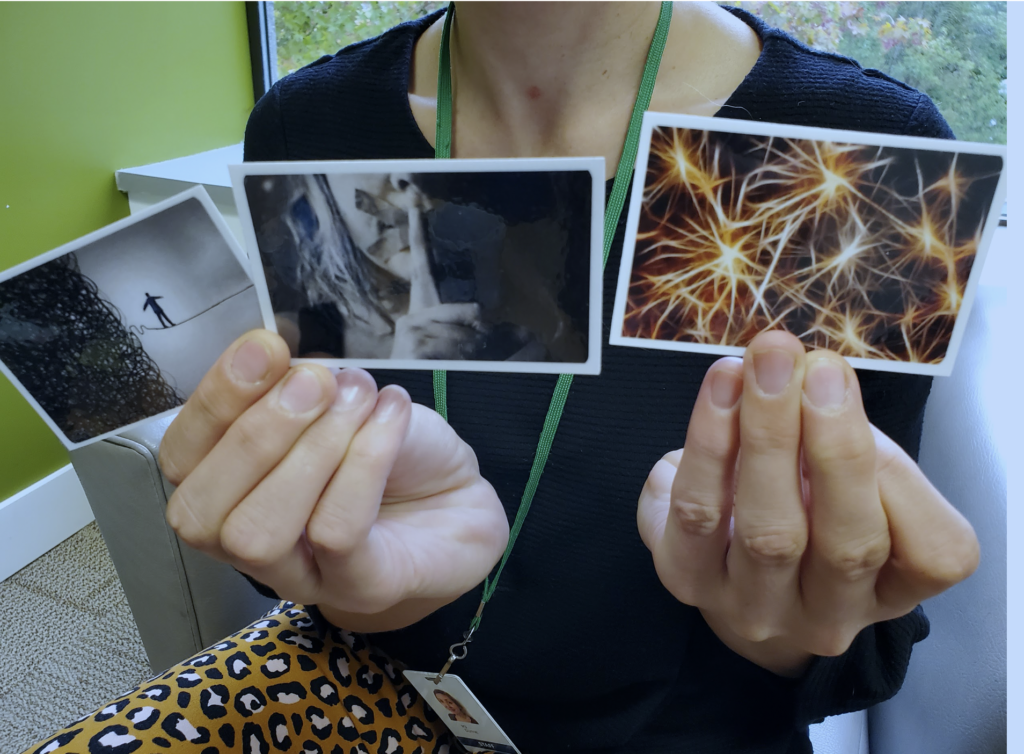
Photo: “Debris” © Loi & McGeachy
Daria Loi (PhD; BArch) is a creative leader with expertise in mixing design strategy with user experience innovation to enrich people’s everyday lives and humanize technology. At Mozilla, she leads Product Design for Emerging Technologies. Previously, Daria was Principal Engineer at Intel and Sr Research Fellow at RMIT. http://www.darialoi.com
Heather McGeachy (MFA) is a creative maker and qualitative researcher with expertise in using deep listening within contextual surroundings to interpret complex relationships humans have with tools and work. Previously, Heather was Head of Design Instruction at Green River CC, and professional artist and gallery owner of Gallery114 in Portland. http://www.dreamoften.info.
Interactive Storytelling: Bringing Personas to Life through an AR/VR Experience
AMY LASATER-WILLE, Oliver Wyman Studio
ALAN FINCH, Oliver Wyman Studio
Personas are an effective way to bring customers to life, enabling business owners and designers to have a better understanding of their audiences’ needs, values and behaviors in detail. Personas help with building and improving product and brand experiences.
There is a diverse set of tools and methods to create personas, and while most are successful in creating detailed stories, they’re mostly limited in terms of creating an immersive experience or building a deeper level of empathy.
Our AR/VR Persona Experience is a unique, dynamic persona engagement tool that uses best-in class interactive storytelling methods and enables audiences to better visualize and connect with their personas’ emotions, habits and aspirations. Based on in-depth, on-site interviews, the AR/VR experience creates an ethnographic experience for the audience in the sense that they are able to deeply acquaint themselves with people and the worlds in which they live, ultimately creating greater understanding and empathy.
Amy Lasater-Wille is the Human Insights Lead at Oliver Wyman Studio. With over a decade of experience in academic and applied consumer research, Amy specializes in bringing a deep understanding of everyday consumer and end-user needs to bear on strategic problems. She holds a B.A. from the University of Chicago and a Ph.D. in anthropology from New York University.
Alan Finch is the Visual Design Lead at Oliver Wyman Studio where he delivers innovative digital solutions for clients across various industries. Before working at Oliver Wyman, he was the Associate Creative Director at POSSIBLE where he brought his love of learning, motion design and digital to deliver innovative, multi-channel experiences for industry leading brands such as Con Edison and Chase Rewards Center. His work has been recognized at the Webby Awards, CSS Awards and MOMA PS1. Alan graduated from the Rhode Island School of Design where he received his BFA in Graphic Design.
Density Done Right : Co-Designing Walkable, Sustainable, and Equitable Communities through Digital and Analog Mediums of Public Engagement
BECKY BUCK, Forge Studio
KARLA SIERRALTA, AIA, University of Hawaiʻi at Mānoa School of Architecture
BRIAN STRAWN, AIA, University of Hawaiʻi Community Design Center
ALISA WEINSTEIN, Google
By 2025, Hawaiʻi needs approximately 65,000, affordable housing units. Geographic location, scarcity of land, astronomic construction costs, and speculative investment have led to an unattainable market. Housing is Hawaiʻi’s most pressing issue. This exhibit shares the “Hawai’i Housing Lab” concept developed by the University of Hawai’i Community Design Center, a public interest design practice led by faculty, researchers, professionals, and students, for the Hawai’i Public Housing Authority, the state’s primary housing agency.
This project was led by two principal investigators with graduate and undergraduate student researchers, in collaboration with an ethnographer and design strategist, the team at KPF Urban Interface, and Alisson Arieff, design and architecture writer at the New York Times, who assisted with framing the conversation for the general public.
Thirty in-home interviews were conducted at 17 public housing properties on five islands, Kauaʻi, Oʻahu, Molokaʻi, Maui and Hawaiʻi. The findings that emerged from the analysis of these contextual interviews, together with secondary research, informed the development of a community engagement process, a design framework, three co-creation tools and a mobile research lab.
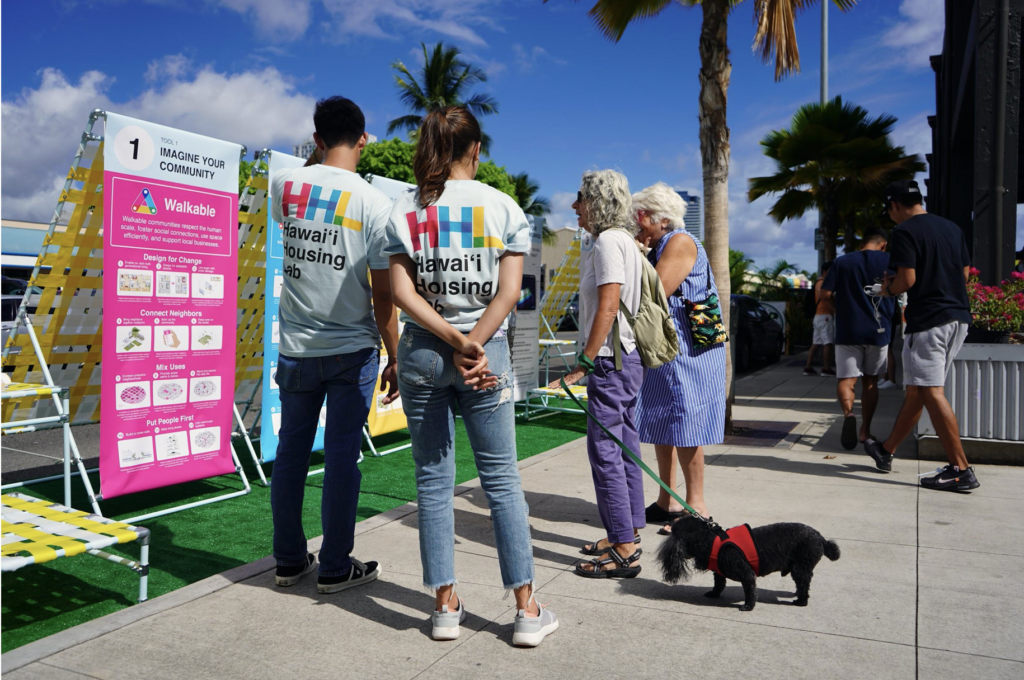
The Hawai’i Housing Lab pilot launch in Honolulu’s Kakaʻako neighborhood during Parking Day 2019. Photo credit: Brian Strawn and Karla Sierralta
Becky Buck is a UX leader working at the intersection of research, design and new product development. She is co-founder at Forge Studio, a strategic design agency that specializes in taming the complexity of enterprise software.
Karla Sierralta, AIA is an Assistant Professor based at the University of Hawai’i at Manoa School of Architecture and co-founder of Strawn+Sierralta, an award-winning, strategy-led architecture, and design studio focused on human-centered spaces, experiences, and services. karla@strawnsierralta.com
Brian Strawn, AIA directs cross-disciplinary teams through projects that cross the fields of service design, design strategy, and architecture. He currently leads public interest design projects for the University of Hawai’i Community Design Center for government agencies, universities, and nonprofits. brian@strawnsierralta.com
Alisa Weinstein is a UX researcher on the Material Design team at Google. Her research is focused on the experience and impact of design system adoption on product development teams and outcomes. She lives in San Francisco.
Vær: On Place, Weather, Being, and Agency
ERICA KOWSZ, University of Massachusetts Amherst
HUNTER STYLES, freelance
This photo installation is a side-product of ethnographic research in Tromsø, a city of 75,000 tucked along the Norwegian coast above the Arctic Circle. The main research addressed longer timeframes—examining Sami ethnopolitics, institution-building, and social change since the 1970s, a time that marked increased engagement of indigenous peoples with national powers in many countries around the world, including in Norway. That project entailed time on-the-ground in Norway’s far north observing the social diacritics of ethnicity in daily life, public events, and local media. Once we arrived, we found that weather and the changing of the light played a dominant role in our daily experience of life above the Arctic Circle, leading us toward this photo exhibit and contemplation. We had to develop techniquess for paying attention to the backdrop—not the microsocial processes of the main research, but rather the steady, shifting hum of the natural world. As a supplement to fieldnotes, shooting quick digital photos and videos became a sensorially-rich means to capture the moment.
In this photo installation, we present images of the environment. We use the visual vocabulary of the changing of the light in the arctic to consider the ways in which the natural world’s rhythms act as the original, powerful “automated” force, challenging humans’ sense of agency, creating the context—and certain limits—for their ability to exert their desired outcomes in the world. How can new technologies of automation be built to suit human life where society is already tailored to rhythms of nature that defy assumptions held by many of us living at lower latitudes? Among these 52 tiles, one for each week of the year, we include black tiles representing the time periods that we have never spent in Tromsø, the gaps in our witnessing of the flow of annual natural cycles and annualized events in the collective social calendar of the Norwegian north. These visual and sensorial “gaps” raise questions about the constraints of ethnographers’ knowledge, the reach of technologists’ innovations into the world’s peripheries, and embodied realities of place. Intermittency isn’t inherently a disadvantage in ethnographic work, but it must be accounted for. How do ethnographers admit, adjust for, and overcome the intermittency of their presence at a fieldwork site? This question is especially pressing for those working in industry environments that demand short timeframes for moving from fieldwork to findings. For technologists, there is a related challenge: how to anticipate the ambient and embodied feeling of life where it is lived when they design products that travel across geographies. We hope this photo display provides a fruitful space for EPIC attendees to consider the strengths and limitations of their own methods.

Evening light at the end of summer in the Lyngen Alps, Troms County, Northern Norway; photo by Erica Kowsz, 2019
Erica Kowsz is a PhD Candidate in the Department of Anthropology at the University of Massachusetts Amherst. She has long term experience with ethnographic research, dating back to a Fulbright project in Canada in 2011-2012. She has since completed ethnographic research programs in the U.S. and Norway. She can be reached at ekowsz@umass.edu.
Hunter Styles is a photographer and journalist, currently working freelance, whose photography and writing capture the sensory and affective dimensions of geographic and cultural diversity in locations ranging from Norway to Japan to small town New England. See more of his photography on Instagram: https://www.instagram.com/hunterstyles/
hi how r u?: Understanding Modern Digital Communication
ERIN RYAN, Carnegie Mellon University Imaginaries Lab
In the absence of physical cues like tone of voice and facial expressions, young people are increasingly using digital communication tools in unexpected or unintended ways to allow for more nuanced online communication. This can involve using punctuation in new ways, spelling words differently, using uppercase and lowercase letters in non- traditional places, and using images, letters, and emojis to create hybrid or intertextual images and emoticons that convey a hyper-specific emotion. This is a new form of digital placemaking that merits its own scrutiny as more and more our digital relationships and interactions hold a weight that rivals our physical ones.
Through a series of workshops, this project explores how digital communication has evolved within the constraints of modern-day messaging platforms, and how it can be furthered without them. These research methods could be used not only to understand and better document the ways in which these tools for digital communication are being used across different demographics, but also as a participatory method to understand how users think and feel in a more visual way. Furthermore, the analog method of collaging digital elements used in these workshops could be adapted to be used with a different set of “tools” to test specific digital design elements to better understand how they might be used and misused by their audience.
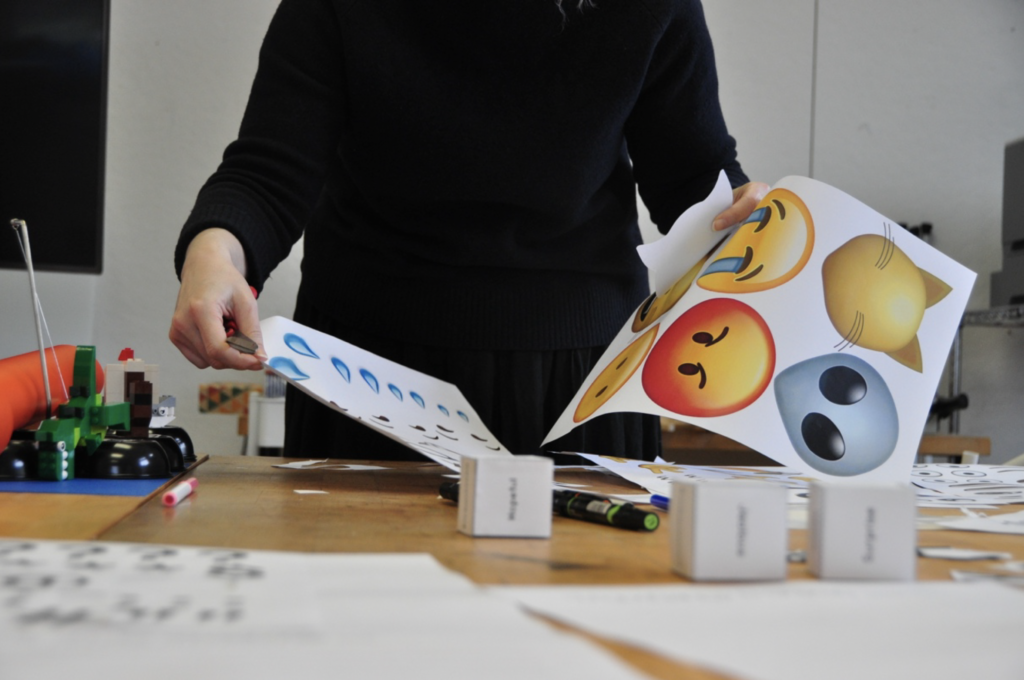
“Initial Workshop” © Erin Ryan
Erin Ryan is a fourth-year design student at Carnegie Mellon with an interest in the relationship between designed artifacts, cultural trends, and behavior. This project was conceived after years of observing and partaking in online culture and communication. If you’re interested in getting in contact, her email is erineryan15@gmail.com.
Where Does Cancer Live Now?
JACOB McAULIFFE, ReD Associates
REBEKAH PARK, ReD Associates
This gallery is a photographic representation of six ethnographic encounters from a 2018 study of people living with Stage-IV lung cancer. Our photographs capture their lives beyond the hectic whirl of machines, medications, and medical workers, instead bringing radically ordinary expressions of agency into focus. For our subjects, the paradoxical condition of living with a terminal disease prompts a deep and ongoing reflection on the routines of everyday life. These become symbols of loss and reclamation of agency: while ruptures in routines can reveal the limitations imposed by cancer treatment, for others daily activities come to signify cancer kept in check. These photographs and narratives bear witness to those meaningful mundanities by depicting artifacts of past lives and evidence of new normals. Our aim is to show the role that rich, sensorial photography can play in presenting visual evidence for what matters most to the patient throughout treatment.
Our photographs also demonstrate the limits imposed on photography by GDPR-regulated healthcare projects, where we must endeavor to capture the lives of people without showing their faces. We found that the very regulatory constraints that threatened to dehumanize our subjects also allowed us to bring their lives into fuller context. Instead of abandoning photography, we depicted the objects, relationships, and places that were most significant to those we met with. These totemic depictions illustrated their relationship with cancer, as well as their shifting evaluations concerning quality of life throughout their cancer journey.
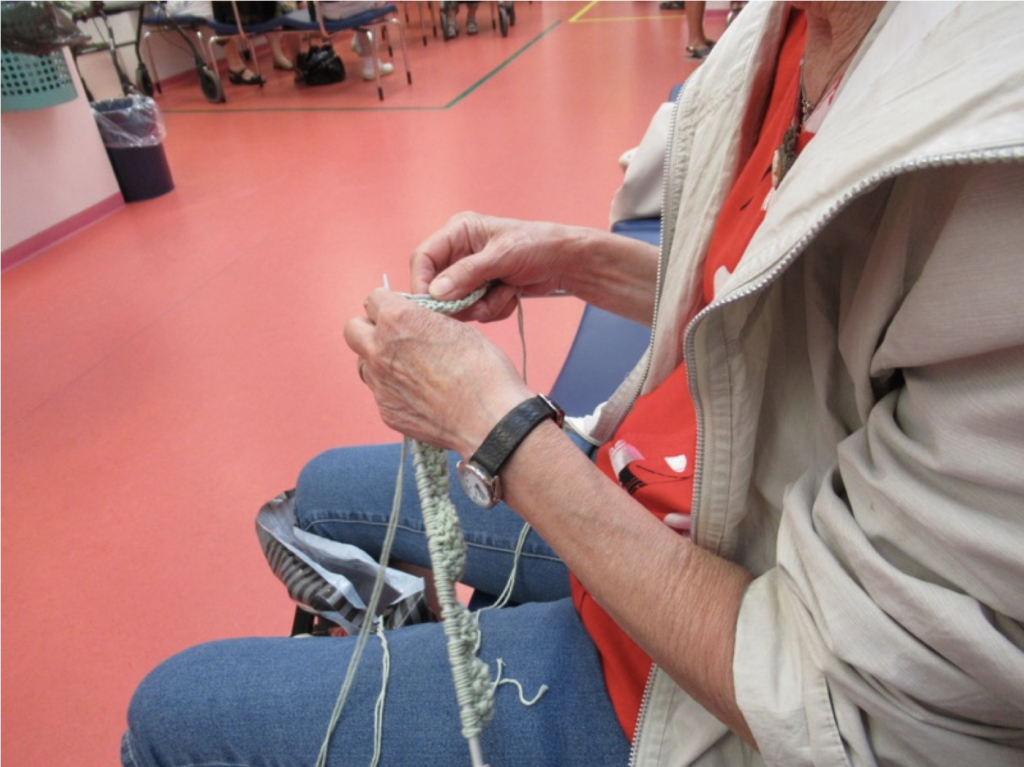
Photo: “The Worst Thing is All the Waiting.” Credit Thomas Hughes
Rebekah Park currently works as a manager at ReD Associates, and holds a PhD in anthropology from UCLA.
Jacob McAuliffe currently works as a consultant at ReD, and holds an MA in history from Yale University.


